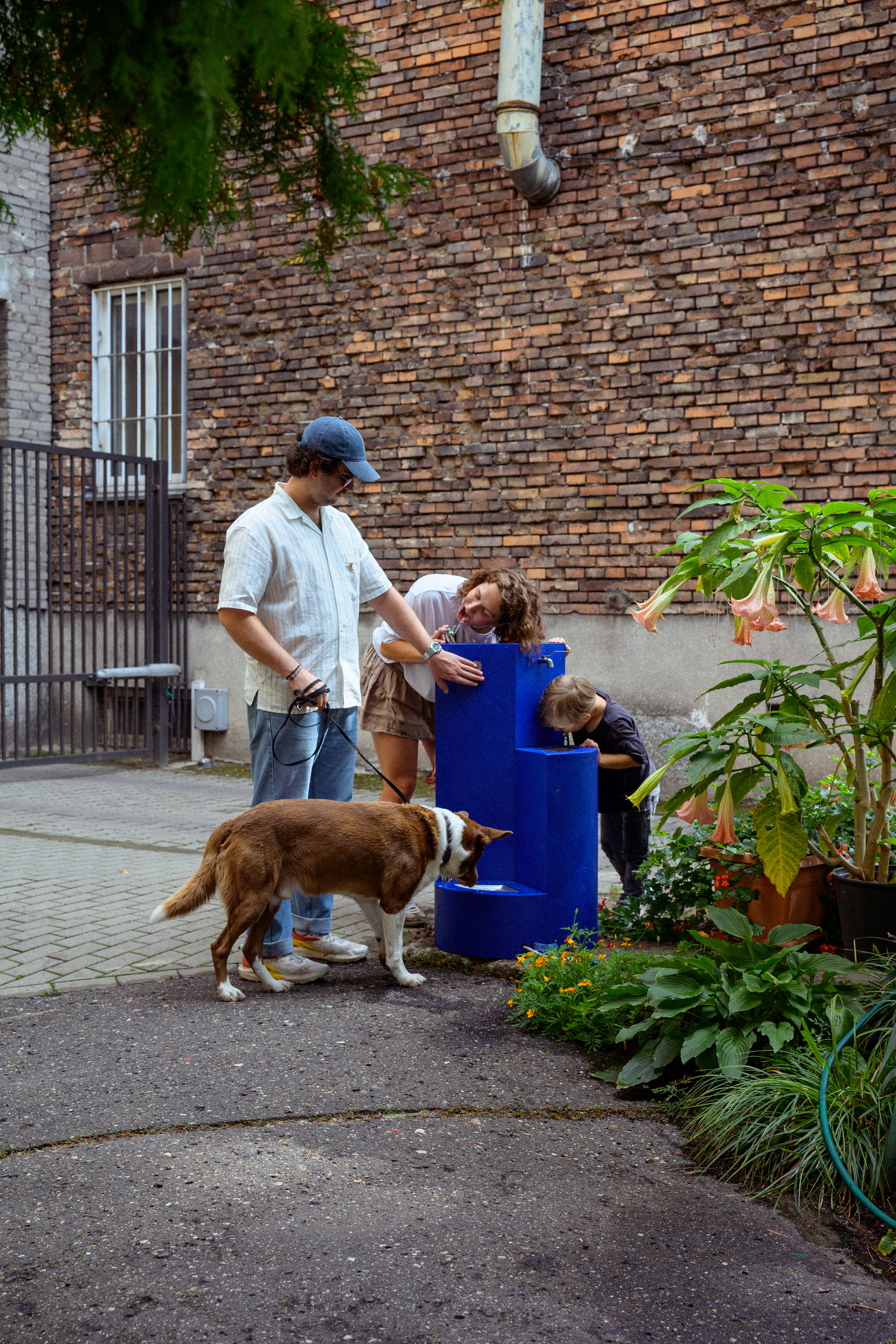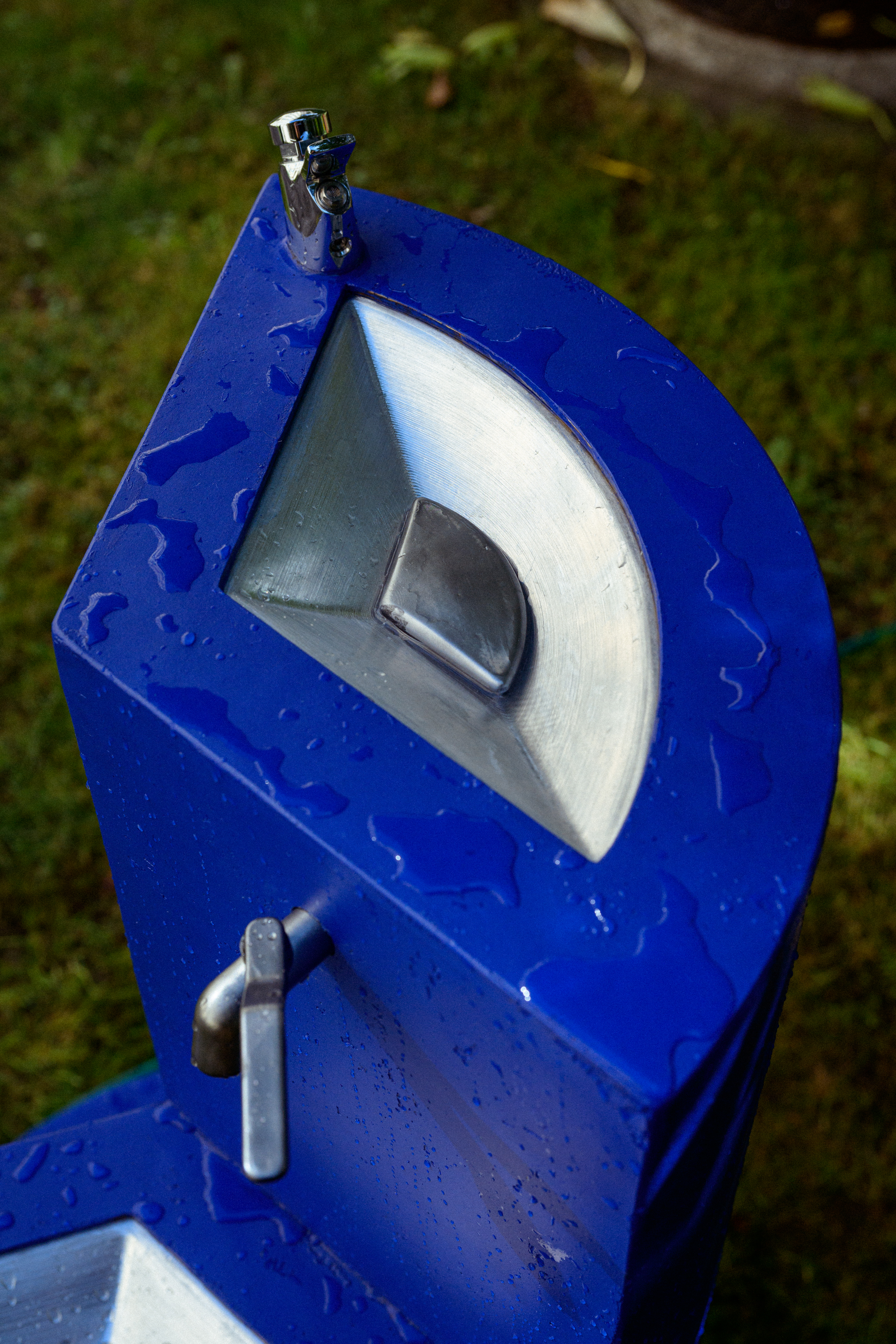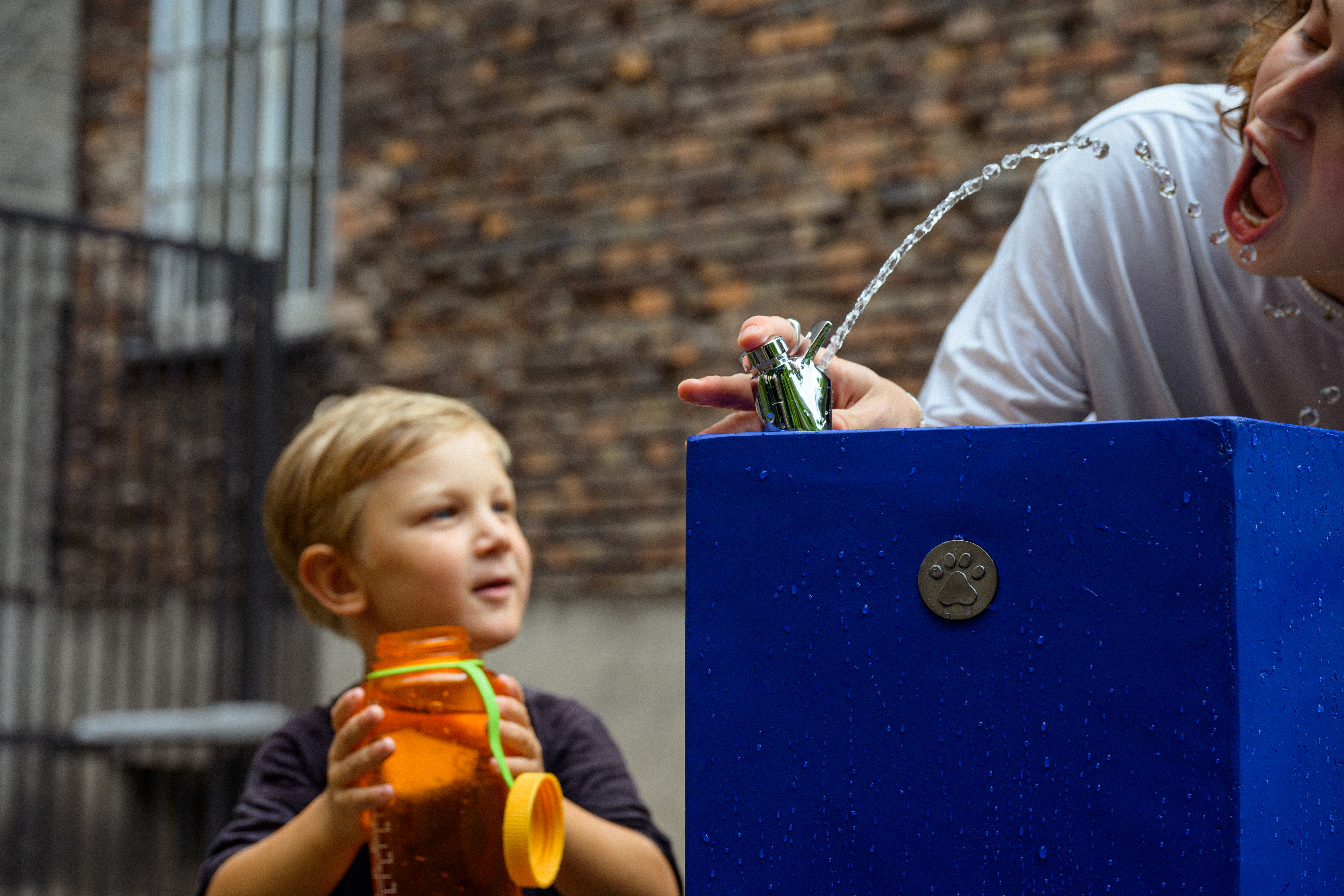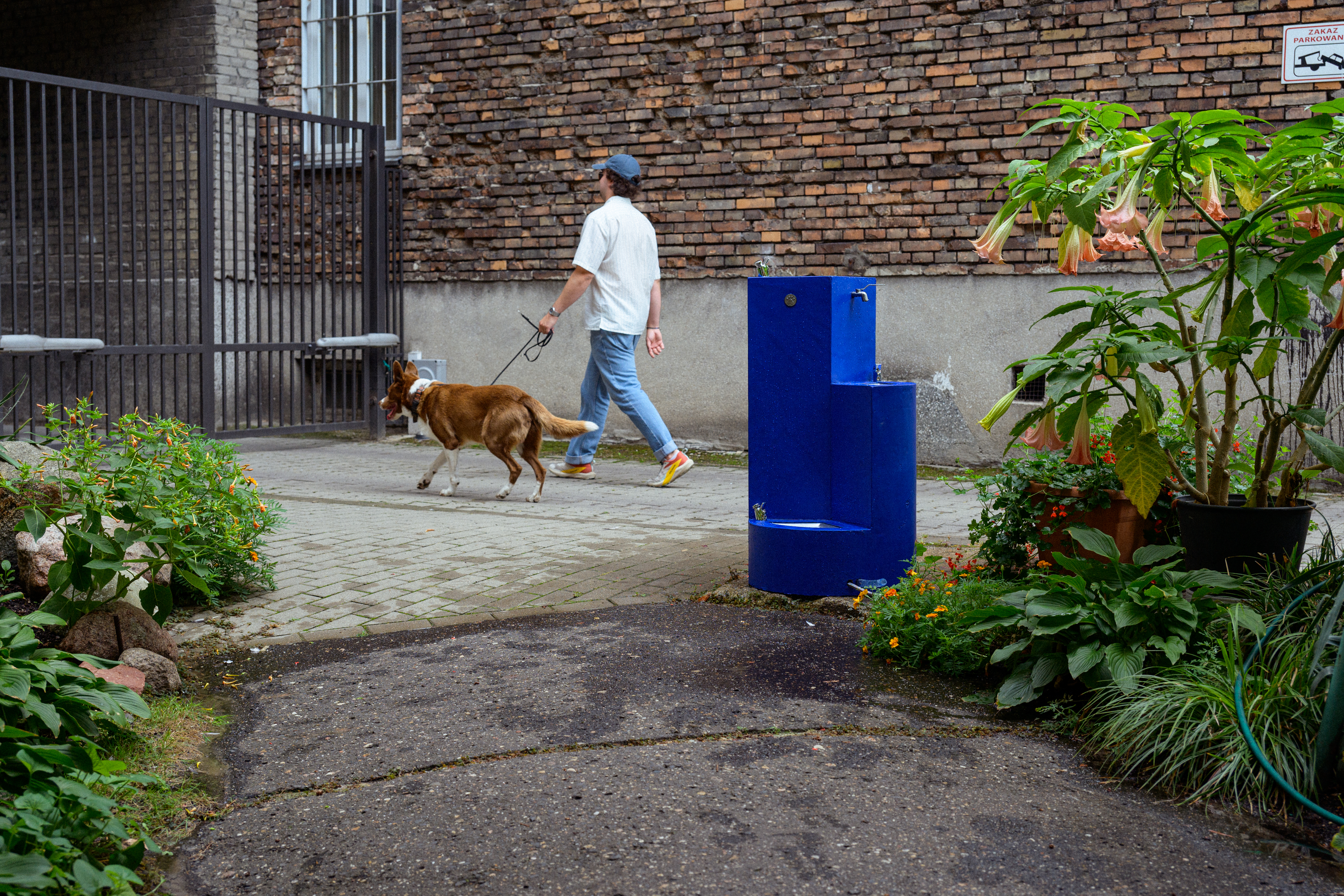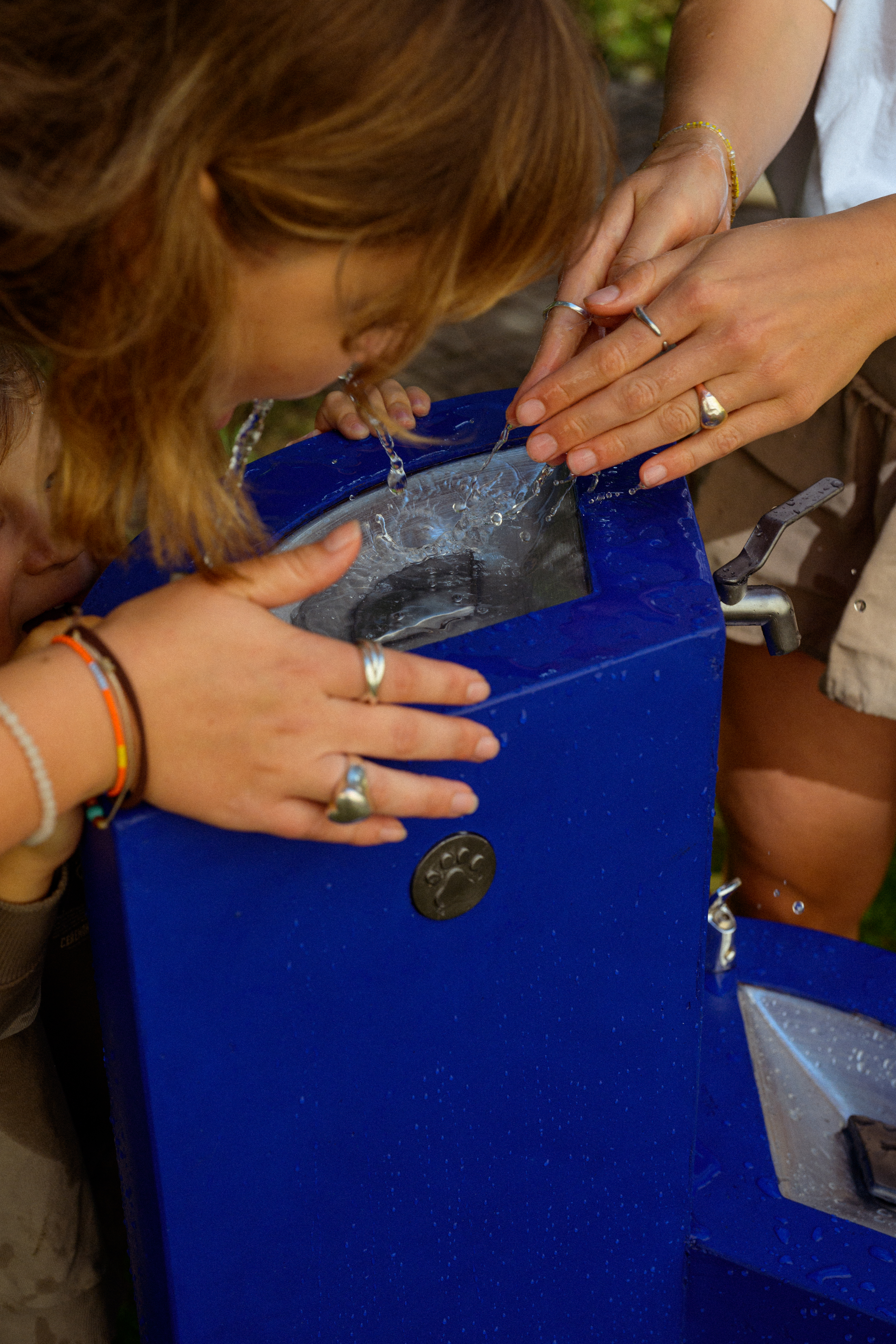Prioritising the places and people that need it the most
"SIP"
“SIP – Sustainable, Inclusive, Public – Fountain”
"SI" is a three-level urban drinking fountain designed for adults, children, and animals. By providing easy access to free drinking water in public spaces, it encourages sustainable habits, reduces plastic waste, and improves urban well-being. Inspired by the history of Warsaw’s water sources, Sip reintroduces the culture of public drinking fountains in a modern, inclusive, and environmentally friendly way. It is designed for year-round use, ensuring access to water even in winter.
Poland
Local
Warsaw, Poland
Mainly urban
It refers to a physical transformation of the built environment (hard investment)
Prototype level
No
No
As an individual
The "SIP" project aligns closely with the core values of the New European Bauhaus - sustainability, inclusivity, and aesthetics - by addressing environmental, social, and cultural challenges in Warsaw’s urban spaces. The overall aim of the project is to create a sustainable public infrastructure that promotes free access to clean drinking water while fostering ecological responsibility and social inclusion. The three-tiered design, serving adults, children, and animals, ensures usability and accessibility for diverse users, while offering flexibility for marginalized groups and visitors.
By integrating sustainable materials like concrete and stainless steel, the project reduces long-term maintenance costs and environmental impact, contributing to the circular economy by minimizing waste from bottled water. Its participatory design process, involving residents and local authorities, helped shape a solution that meets real needs, improves social cohesion, and ensures long-term adoption.
The project addresses several challenges faced by Warsaw, such as plastic pollution, public health concerns, and insufficient access to public drinking water. Many public spaces in the city lack sufficient hydration points, leading to an overreliance on bottled water and the generation of waste. The "SIP" fountain provides an eco-friendly and practical alternative while promoting sustainable, resource-conscious behavior.
In the long term, the project contributes to creating healthier, more inclusive urban spaces where residents and visitors can interact, stay hydrated, and connect with their surroundings. The choice of cobalt-blue concrete makes the fountain visually distinct, creating a functional urban landmark. As a replicable solution, the project offers lessons for other cities facing similar challenges, showcasing how innovative design can bridge environmental, social, and practical needs.
By integrating sustainable materials like concrete and stainless steel, the project reduces long-term maintenance costs and environmental impact, contributing to the circular economy by minimizing waste from bottled water. Its participatory design process, involving residents and local authorities, helped shape a solution that meets real needs, improves social cohesion, and ensures long-term adoption.
The project addresses several challenges faced by Warsaw, such as plastic pollution, public health concerns, and insufficient access to public drinking water. Many public spaces in the city lack sufficient hydration points, leading to an overreliance on bottled water and the generation of waste. The "SIP" fountain provides an eco-friendly and practical alternative while promoting sustainable, resource-conscious behavior.
In the long term, the project contributes to creating healthier, more inclusive urban spaces where residents and visitors can interact, stay hydrated, and connect with their surroundings. The choice of cobalt-blue concrete makes the fountain visually distinct, creating a functional urban landmark. As a replicable solution, the project offers lessons for other cities facing similar challenges, showcasing how innovative design can bridge environmental, social, and practical needs.
Sustainable design
Public hydration
Urban inclusion
Environmental impact
Human-animal coexistence
The project’s sustainability objectives center on creating a long-term, environmentally responsible solution to public hydration needs. The design addresses waste reduction by encouraging the use of tap water instead of bottled water, thereby reducing plastic pollution. The materials - stainless steel for hygiene and durability, and concrete for structural integrity - were chosen for their low maintenance, resilience to weather conditions, and long lifespan, ensuring minimal environmental impact over time. The project also promotes behavioral change, encouraging citizens to shift toward sustainable habits by showcasing an eco-friendly alternative to single-use plastics. Public awareness initiatives could further enhance the project’s impact, illustrating how design can influence broader environmental goals. This fountain is an example of how small-scale, thoughtful urban interventions can contribute to larger sustainable development objectives in modern cities.
The project prioritizes aesthetics and user experience by blending form, function, and symbolism. The fountain’s design features clean, minimalist forms and a distinct cobalt-blue color, inspired by Yves Klein, that represents water and vitality, while its bright color makes it easy to spot and associate with hydration and refreshment. The three-tiered, cylindrical structure reflects a simple, geometric form that is practical yet symbolic. When viewed from above, its circular shape represents unity and equality, emphasizing that public resources should be accessible to all - whether adults, children, or animals such as dogs.The design’s tactile, ergonomic features, such as smooth stainless steel basins and easy-to-use taps, ensure that users interact with the fountain comfortably and intuitively. The three distinct levels create an inclusive experience while maintaining a sense of cohesion between users of different needs. Durable materials such as concrete and stainless steel enhance the sensory experience by providing cool, smooth surfaces that reinforce the perception of hygiene and quality. This combination of simplicity, symbolism, and inclusivity demonstrates how aesthetics can serve a functional purpose while fostering a sense of place and belonging.
The "SIP" project embodies inclusive design by addressing the diverse needs of urban users. The three-tiered structure caters to various groups: the highest level for adults, the mid-level for children, and the lowest for animals such as dogs and birds. This tiered design reflects a commitment to multi-species inclusion, recognizing that public spaces serve more than just human users. Special attention was given to ensuring accessibility for people with disabilities by designing ergonomic heights and easy-to-operate taps. Affordability and long-term cost-efficiency were considered through the use of low-maintenance materials, making the solution scalable to other public locations. Research and field studies involving the local community helped identify a real problem in Warsaw’s urban space - limited access to free, clean drinking water. The insights gathered during these studies guided key design decisions, such as the inclusion of a separate tap for refilling water bottles, ensuring the fountain met the diverse needs of its users. By creating a shared resource for diverse users, the project exemplifies how urban design can promote equity and foster social cohesion in public spaces.
Citizen involvement was a crucial part of the project, ensuring that the final design reflected real user needs and preferences. Extensive ethnographic research conducted at Warsaw’s Skwer Batalionu AK "Zaremba-Piorun" involved observing how residents, pet owners, and other regular users interacted with the space. This research revealed the community’s need for a public drinking fountain that could serve both people and animals, highlighting the importance of such infrastructure in urban areas. Additionally, surveys gathered specific feedback on key design features, such as the importance of ergonomic heights, hygiene concerns, and aesthetic preferences. The combination of these insights guided important design decisions, including the choice of durable materials, the three-tiered structure, and the inclusion of a separate tap for refilling water bottles. By involving citizens through both observation and direct feedback, the project supported a sense of shared ownership, increasing the likelihood of long-term community engagement and responsible use of the fountain.
The success of the "SIP" project was built on the collaboration of diverse stakeholders, including residents, design specialists, and academic mentors. During the research phase, Warsaw residents and regular users of the Skwer Batalionu AK "Zaremba-Piorun" played a key role in shaping design decisions by providing critical insights through ethnographic studies and on-site observations. Additionally, a survey targeting Warsaw residents was conducted to gather feedback on specific design features, such as usability, hygiene, and accessibility. During the conceptual and prototyping stages, I collaborated with various specialists to ensure the technical feasibility and quality of the design. These included consultations with hydraulic experts, an architect, a concrete specialist, and companies supplying equipment for public fountains and microcement materials. Their expertise helped refine key aspects such as material selection, water flow systems, and structural integrity. As this was my diploma project, I benefited from the guidance of two academic advisors: an anthropologist and a design specialist. Their mentorship provided critical feedback on integrating user research with design solutions and ensured that the project maintained both academic rigor and practical relevance.
The project brought together multiple disciplines, including urban design, environmental science, sociology, and hydraulic engineering. Urban design guided the creation of an aesthetically pleasing and functional public structure, while environmental science ensured that sustainability was prioritized through material selection. Sociological research, particularly ethnographic studies and surveys, helped identify user needs, behavioral patterns, and social challenges related to public water access. Hydraulic engineers ensured the technical feasibility of the water distribution system, addressing concerns about flow control and maintenance. Experts from different fields worked together, helping each other, which led to a practical, user-friendly design that works well both technically and socially, while also caring for the environment.
The "SIP" project introduces several key innovations that distinguish it from mainstream public drinking fountains typically found in Poland. One of the most significant is its minimalist, cylindrical form, consisting of a three-tiered design cut at three different levels. This simple yet functional form balances aesthetics with practicality, ensuring access for adults, children, and animals, unlike traditional fountains, which often offer only two or even just one level. The basins, following the cylindrical structure, provide a unique, visually appealing shape and include covered drains to prevent clogs, addressing common maintenance issues. Another major innovation is the fountain’s suitability for year-round use, unlike most models on the market, which are shut down in winter. Additionally, the use of durable concrete, combined with select stainless steel components, creates a more user-friendly design compared to standard all-steel fountains, which survey respondents associated negatively with hygiene. The distinct cobalt-blue color further sets it apart, making it a recognizable urban landmark. Functionally, the fountain offers rare features like a tap for refilling bottles - identified as a need in surveys - and a separate water dispensing system for animals, activated by a button on the highest tier. Overall, the project’s simplicity and universal design make it adaptable and scalable across different urban contexts, from parks to streets and squares.
The "SIP" project utilized a comprehensive, user-centered design methodology combining ethnographic research, surveys, and iterative design processes to address real user needs and environmental challenges. The approach began with on-site ethnographic research at Skwer Batalionu AK "Zaremba-Piorun" in Warsaw. Observations and interviews with local residents and pet owners highlighted the need for accessible public water points and the specific challenges faced in urban environments. This qualitative research provided the foundation for understanding behavioral patterns and user priorities.
Following the field research, a quantitative survey was conducted, targeting 90 Warsaw residents to gather broader insights. The survey explored preferences related to the materials, functionality, and aesthetics of public fountains, identifying key features such as ergonomic heights, separate taps for water bottles, and improved hygiene standards. The results directly influenced core design decisions, including the integration of a three-tiered structure and the functional layout of the basins.
During the concept development phase, the design was refined step by step through sketching, 3D prototyping, and feedback from specialists, including an architect, hydraulic engineer, and concrete expert. Collaboration with technical experts ensured that the project was practical, durable, and feasible for real-world application.
The final phase involved prototyping and testing, where a functional prototype was created using plywood and microcement to simulate concrete. This iterative process allowed for adjustments in design details, such as the shape of the basins and the positioning of water taps, ensuring both technical reliability and user satisfaction. By combining interdisciplinary expertise, community feedback, and iterative development, the methodology ensured that the final design was both practical and scalable across various public spaces.
Following the field research, a quantitative survey was conducted, targeting 90 Warsaw residents to gather broader insights. The survey explored preferences related to the materials, functionality, and aesthetics of public fountains, identifying key features such as ergonomic heights, separate taps for water bottles, and improved hygiene standards. The results directly influenced core design decisions, including the integration of a three-tiered structure and the functional layout of the basins.
During the concept development phase, the design was refined step by step through sketching, 3D prototyping, and feedback from specialists, including an architect, hydraulic engineer, and concrete expert. Collaboration with technical experts ensured that the project was practical, durable, and feasible for real-world application.
The final phase involved prototyping and testing, where a functional prototype was created using plywood and microcement to simulate concrete. This iterative process allowed for adjustments in design details, such as the shape of the basins and the positioning of water taps, ensuring both technical reliability and user satisfaction. By combining interdisciplinary expertise, community feedback, and iterative development, the methodology ensured that the final design was both practical and scalable across various public spaces.
The "SIP" project is designed with versatility and scalability in mind, making several of its elements highly transferable across various locations and contexts. The core feature - the three-tiered cylindrical design - is adaptable to different public spaces, such as parks, urban squares, and residential areas. It serves diverse users, including adults, children, and animals, without requiring modifications.
The simple, totemic form is visually neutral yet distinctive, allowing it to blend into different environments while remaining functional. The cobalt-blue color can be adapted to local preferences.
The fountain is designed for year-round use, with thermal insulation protecting the water supply and a concrete foundation ensuring stability, even in colder climates. This allows secure installation on various surfaces, such as paved squares or natural ground, making it suitable for both urban and suburban areas.
Durable materials like concrete and stainless steel ensure longevity and low maintenance, supporting easy replication. The production process, including the potential use of local concrete or microcement, allows cost-efficient implementation.
The project’s participatory design approach - combining ethnographic research, surveys, and prototyping - can be replicated by other municipalities to create community-driven solutions.
Functional features, such as the separate bottle refill tap and the button-activated pet basin, are integrated into the fixed three-level structure, ensuring accessibility for all users, while details like finishes or tap designs can be adjusted locally.
The simple, totemic form is visually neutral yet distinctive, allowing it to blend into different environments while remaining functional. The cobalt-blue color can be adapted to local preferences.
The fountain is designed for year-round use, with thermal insulation protecting the water supply and a concrete foundation ensuring stability, even in colder climates. This allows secure installation on various surfaces, such as paved squares or natural ground, making it suitable for both urban and suburban areas.
Durable materials like concrete and stainless steel ensure longevity and low maintenance, supporting easy replication. The production process, including the potential use of local concrete or microcement, allows cost-efficient implementation.
The project’s participatory design approach - combining ethnographic research, surveys, and prototyping - can be replicated by other municipalities to create community-driven solutions.
Functional features, such as the separate bottle refill tap and the button-activated pet basin, are integrated into the fixed three-level structure, ensuring accessibility for all users, while details like finishes or tap designs can be adjusted locally.
This project addresses several global challenges, including environmental sustainability, public health, and social equity, by providing practical and locally tailored solution. One of the most pressing global issues it tackles is the reduction of plastic waste. By promoting access to free, clean tap water, the project helps reduce dependence on bottled water, a big contributor to plastic pollution worldwide. The fountain’s design encourages the use of reusable bottles, directly addressing the need for environmentally sustainable urban infrastructure.
Another key challenge it responds to is the impact of climate change, particularly heatwaves and the growing demand for access to drinking water in public spaces. The project provides critical infrastructure that ensures hydration in high-temperature urban environments, minimizing the risks of dehydration among residents, tourists, and marginalized groups such as the homeless. This solution supports the broader global goal of climate adaptation in urban areas.
The fountain also contributes to the promotion of public health, similar to historical urban interventions that aimed to improve living conditions by providing clean water. Access to safe drinking water is a recognized human right, and this project emphasizes its importance by ensuring inclusive access for adults, children, and animals.
Additionally, the project fosters social inclusion and community well-being. The three-tiered design, combined with ergonomic features and thoughtful placement, turns public spaces into more equitable and accessible environments. It not only improves access to water but also enhances the quality of public interactions and gatherings.
Another key challenge it responds to is the impact of climate change, particularly heatwaves and the growing demand for access to drinking water in public spaces. The project provides critical infrastructure that ensures hydration in high-temperature urban environments, minimizing the risks of dehydration among residents, tourists, and marginalized groups such as the homeless. This solution supports the broader global goal of climate adaptation in urban areas.
The fountain also contributes to the promotion of public health, similar to historical urban interventions that aimed to improve living conditions by providing clean water. Access to safe drinking water is a recognized human right, and this project emphasizes its importance by ensuring inclusive access for adults, children, and animals.
Additionally, the project fosters social inclusion and community well-being. The three-tiered design, combined with ergonomic features and thoughtful placement, turns public spaces into more equitable and accessible environments. It not only improves access to water but also enhances the quality of public interactions and gatherings.
Following the application, my first step will be to engage with local authorities, public space managers, and environmental organizations to discuss potential pilot locations for SIP. Simultaneously, I will collaborate with urban furniture manufacturers and water system experts to refine the design, paying special attention to developing a stable base for flexible installation on various surfaces.
Once the design is finalized, I will produce the first prototype and launch an information campaign. This will include a website and social media channels showcasing SIP’s role in supporting both people and their pets. The prototype will be installed in a chosen public space, and I will closely monitor its performance, gathering feedback from users. Based on these insights, I will introduce adjustments if necessary.
Throughout the year, I will focus on promoting SIP to other cities, emphasizing its adaptable design. I will attend urban design and sustainability events to present the project and build a network of potential partners.
Finally, I will organize a public event at the pilot site to summarize the year’s achievements and inspire other municipalities to adopt SIP, ensuring the project’s long-term growth and contributing to more inclusive and nature-friendly urban environments.
Once the design is finalized, I will produce the first prototype and launch an information campaign. This will include a website and social media channels showcasing SIP’s role in supporting both people and their pets. The prototype will be installed in a chosen public space, and I will closely monitor its performance, gathering feedback from users. Based on these insights, I will introduce adjustments if necessary.
Throughout the year, I will focus on promoting SIP to other cities, emphasizing its adaptable design. I will attend urban design and sustainability events to present the project and build a network of potential partners.
Finally, I will organize a public event at the pilot site to summarize the year’s achievements and inspire other municipalities to adopt SIP, ensuring the project’s long-term growth and contributing to more inclusive and nature-friendly urban environments.

